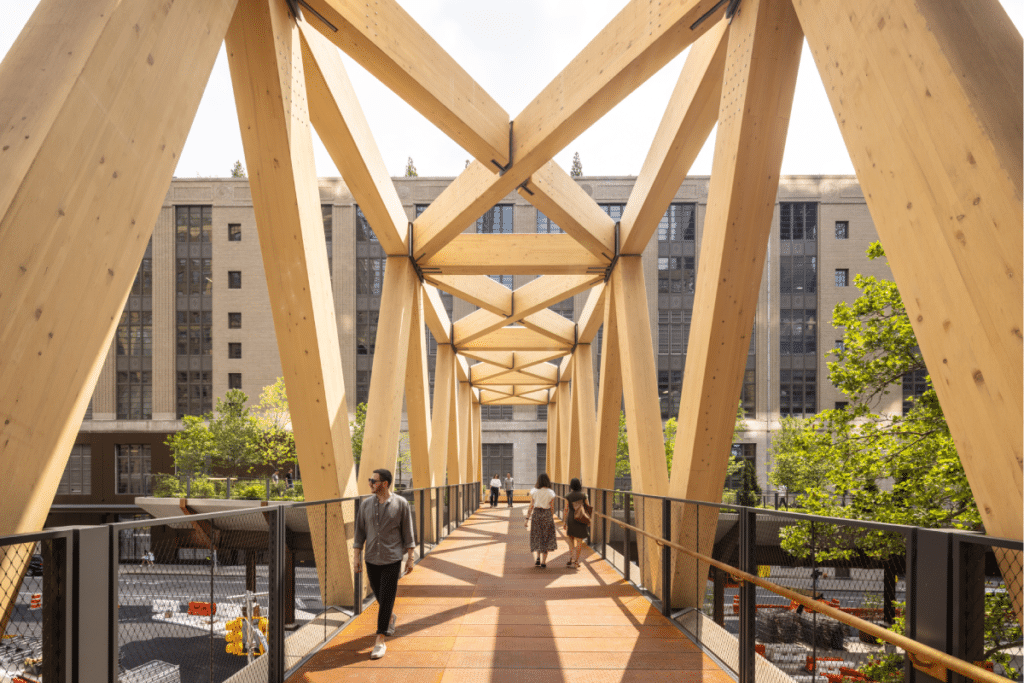
On Wednesday, June 21, Governor Hochul, Empire State Development, The Port Authority of New York and New Jersey, Brookfield Properties, and Friends of the High Line gathered together to cut the ribbon at the new Moynihan Connector, and it’s now officially open to the public!
The Moynihan Connector is a new elevated pathway that gives pedestrians a safe connection between Penn Station’s glowing expansion, the fairly new Moynihan Train Hall, and one of NYC’s best parks, the High Line.

Former Governor Andrew Cuomo made the initial announcement about the project back in his 2021 State of the State address, saying that it would be part of “the most ambitious redevelopment that New York City has seen in decades” (including other plans for redeveloping the West Side like Penn Station renovations & more).
The High Line extension cost $50 million, paid for through a public-private partnership including the Empire State Development, the Port Authority of New York and New Jersey, Brookfield Properties Group, and Friends of the High Line.

The new elevated path, called the “Moynihan Connector,” joins the High Line at 30th Street to the Moynihan Train Hall through the new Manhattan West public plaza on 31st Street and Dyer Avenue. It allows New Yorkers to walk from Penn Station to the Meatpacking District by only crossing a singular street!
This path was created through two intersecting bridges: the landscaped Woodlands Bridge that extends eastward from the existing High Line Spur (parallel to 30th Street) along Dyer Avenue from 10th Avenue to the mid-block between 9th and 10th Avenues, where connects to a second Timber Bridge that was installed 25-feet above Dyer Avenue between West 30th and West 31st Streets.
The 128-ton, 600-foot-long connector effectively links Midtown to the West Village.

The entire project ends on 9th Avenue directly across from the entrance to the Farley Building and the new Moynihan Train Hall. Ground broke on the Connector in February 2022, and construction was completed in just 18 months.
The green-ified Woodland Bridge will essentially function as a 370-foot-long planter, with custom-shaped precast concrete panels that can hold up to five feet of soil and be home to flowers, plants, and even large-scale trees. The bridge’s walkway is suspended over the planter soil, with perforations for rainwater, allowing for natural irrigation.
In addition to natural elements, the bridges will also provide more space for the High Line’s famous public art installations.

Extending the High Line gives pedestrians safe, unobstructed access to the far West Side of Manhattan via two bridges that connect to the 10th Avenue terminus of the High Line, the original press release shared.
“The Moynihan Connector will add 600 feet of new open space to transform one of New York City’s busiest neighborhoods. This project is a testament to the power of smart, sustainable design, enhancing one of the most beloved parts of the city, and I encourage New Yorkers and visitors to take advantage of this beautiful new space,” said Governor Hochul.

“These gorgeous new bridges are a great example of a public-private partnership working to make our city better for New Yorkers,” said NYC Parks Commissioner Sue Donoghue.
“Our partnerships are integral in our efforts to expand, maintain, and promote our city’s parks and greenspaces, and I’m so excited to welcome New Yorkers to the city’s newest open space,” she added.
🕓 Open to the public June 22, 2023
📍Manhattan West to 9th Avenue and to Moynihan Train Hall

